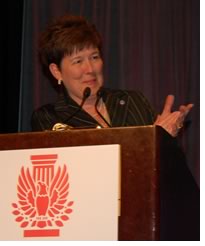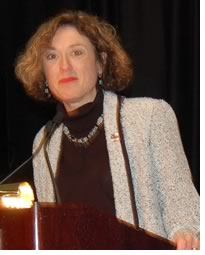

2/2006

 “I’m delighted to welcome you, the leaders of this profession,
veterans and newcomers, boomers and “millennials,” component
and knowledge leaders, staff and volunteers, young and not-so-young alike,
to the 2006 AIA Grassroots Leadership Conference, the largest by far in
our history,” said AIA President Kate Schwennsen, FAIA, as she welcomed
the almost 900 attendees to the nation’s capital. “I am truly
amazed and grateful for the depth of talent gathered today in this room
and this week in Washington.”
“I’m delighted to welcome you, the leaders of this profession,
veterans and newcomers, boomers and “millennials,” component
and knowledge leaders, staff and volunteers, young and not-so-young alike,
to the 2006 AIA Grassroots Leadership Conference, the largest by far in
our history,” said AIA President Kate Schwennsen, FAIA, as she welcomed
the almost 900 attendees to the nation’s capital. “I am truly
amazed and grateful for the depth of talent gathered today in this room
and this week in Washington.”
Schwennsen told the audience that to leverage that talent toward enabling us to reach our full potential as a 21st-century profession will require us to change the “how,” the “who,” and the “what” of architectural practice:
- The “how” needs to become both more personal and more digitized
- The ”what” needs to become more innovative, knowledge-based, and sustainable
- The “who” needs to become more inclusive.
“As caretakers of this profession, your job and mine is to help our members and our communities not simply to survive, but to prosper,” Schwennsen said. “Think ahead . . . What do we hope for the generation of architects who will be planning our bicentennial? . . . I am confident of our success. And when we achieve it, as we surely will, we will all come closer toward our shared goal of One AIA.” Schwennsen concluded with an introduction of the AIA’s new Executive Vice President/CEO Chris McEntee, noting that she is the first woman CEO in the Institute’s history.
 McEntee welcomed the group on behalf of the national AIA staff. “I’m
truly honored to take this position,” she said, noting that she
was particularly attracted when she discovered which issues the members
care about. She stressed the importance of working as a team, and that “we
are the team.” Her management style, she emphasized, acknowledges
the benefits of hitting singles on a day-to-day basis over swinging for
the occasional home run. “If everyone of the over 800 people in
this room each hit one single today, we would score more than 200 runs,” she
said.
McEntee welcomed the group on behalf of the national AIA staff. “I’m
truly honored to take this position,” she said, noting that she
was particularly attracted when she discovered which issues the members
care about. She stressed the importance of working as a team, and that “we
are the team.” Her management style, she emphasized, acknowledges
the benefits of hitting singles on a day-to-day basis over swinging for
the occasional home run. “If everyone of the over 800 people in
this room each hit one single today, we would score more than 200 runs,” she
said.
One of the challenges McEntee intends to address early on is the question of “How do we make ‘One AIA’?” “We need to shift focus from the walls that separate us to the values and visions that bind us together,” she said. The new CEO invited all present to speak freely to her: “Tell me who you are, what you do, where you’re from, and what you care about,” she said. McEntee promised to listen and return with some ideas on how to work together to meet common goals.
 AIA 2006 First Vice President and Grassroots Leadership Conference Chair
RK Stewart, FAIA, then outlined the program for the next three days of
the conference. “I guarantee you will never feel more empowered,
more connected, and more hopeful about the future—the AIA’s,
the profession’s, and our communities’,” Stewart promised. “Don’t
forget that feeling once you’re back home. Make a special place
for it in your suitcase. Take it with you and work the rest of the year
to make the halo effect of this Grassroots—the enthusiasm, the
fellowship, the knowledge that One AIA is possible—a permanent
fact of your AIA life.”
AIA 2006 First Vice President and Grassroots Leadership Conference Chair
RK Stewart, FAIA, then outlined the program for the next three days of
the conference. “I guarantee you will never feel more empowered,
more connected, and more hopeful about the future—the AIA’s,
the profession’s, and our communities’,” Stewart promised. “Don’t
forget that feeling once you’re back home. Make a special place
for it in your suitcase. Take it with you and work the rest of the year
to make the halo effect of this Grassroots—the enthusiasm, the
fellowship, the knowledge that One AIA is possible—a permanent
fact of your AIA life.”
Stewart noted that, in many cases, Grassroots attendees are arriving as strangers; and will be leaving as colleagues, partners, and friends. “My hope is that we inspire one another to achieve more than we believed possible,” he concluded.
Copyright 2006 The American Institute of Architects.
All rights reserved. Home Page ![]()
![]()
With particularly timely publication, AIA President Kate Schwennsen, FAIA, had a letter to the editor published in The Washington Post on February 7 under the banner “Forgetting the Pledge to New Orleans.” In her letter, Schwennsen took the administration to task for not supporting H.R. 4100 to establish the Louisiana Recovery Corp. to provide for the economic stabilization and redevelopment of those areas of Louisiana that were devastated by Hurricane Katrina. She also described how 700 AIA architects would be visiting the Hill on February 9 to urge passage of the bill. Read the text of Schwennsen’s letter.
![]()